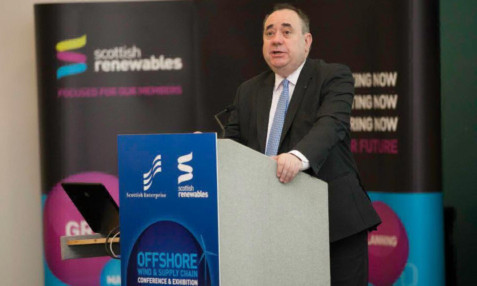First Minister Alex Salmond moved to provide confidence for would-be investors in the renewable energy sector by announcing a target to cut 80% of carbon emissions by 2030.
He told a joint Scottish Renewables-Scottish Enterprise conference for the offshore wind industry that the target would give some surety to finance providers over the longer term, while also helping to tackle the effects of climate change.
The new goal extends existing targets by seeking to reduce carbon dioxide emissions per kilowatt hour of electricity generated from its 2010 level of 347 grams to just 50g in around 17 years’ time.
A similar target has been withheld from UK Government legislation until 2016.
“Offshore wind has a strong, vibrant future, with plans to install up to 10GW of capacity in Scottish waters over the next decade,” Mr Salmond said.
“More sites are being scoped for deployment in the 2020s alongside commercial wave and tidal generation as grid and interconnection upgrades and storage are further developed.
“Having stated our ambition for a largely-decarbonised electricity supply by 2030, the Scottish Government is now setting a specific target to guide our overall policy approach and set the context for decisions on applications for electricity generation.”
The move was welcomed by Scottish Renewables chief executive Niall Stuart and Dan Finch of developer EDPR.
The Portuguese firm, a majority partner in the 1,500MW Moray Offshore Wind development and a 49% stakeholder in the prospective 1MW Inch Cape development off the coast of Angus, is one of a string of wind developers waiting for consents to be granted for prospective projects off Scotland’s east coast.
Several have cited the granting of permissions and ongoing UK electricity market reform as hurdles to building-out their arrays, with three expecting to get the nod from Marine Scotland later this year.
Mr Finch said the industry would benefit from “timely” decision-making.
“It is the reduction of risk and creation of market certainty which are key to creating the confidence which will allow others to share our vision and invest in this supply chain,” he told conference delegates.
“The earlier we can give certainty and the better definition we gain then the sooner the offshore market and the offshore supply chain in Scotland will benefit.”
Asked by The Courier when he expected consents would be granted, the First Minister said he would not seek to direct timescales but would let Marine Scotland complete its deliberations in the “correct manner”.
Mr Salmond also announced a tie-up between Highlands and Islands Enterprise and four ports in the north with the aim of supporting the development of the offshore wind sector off the north-west coast.
It is hoped the partnership with port management at Ardersier, Kishorn, Cromarty and Nigg will support owners and operators as they seek to secure development worth up to an estimated £100 million in the years to come.
